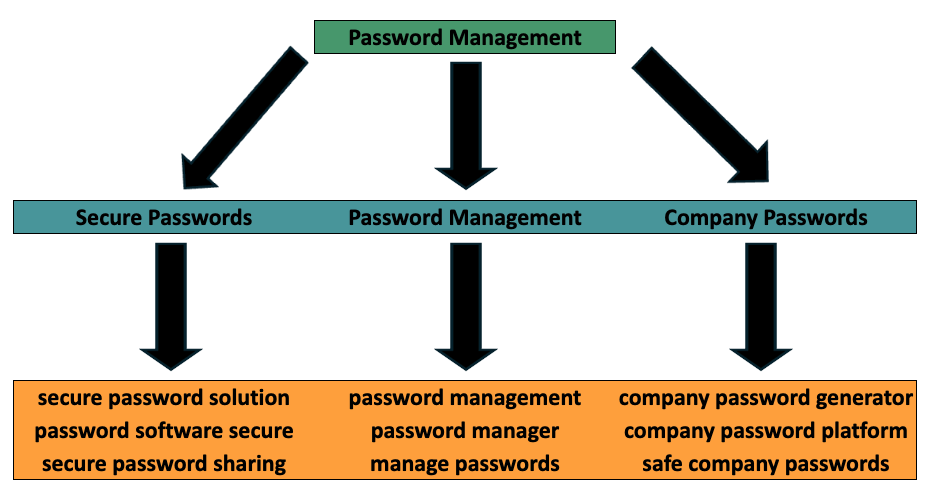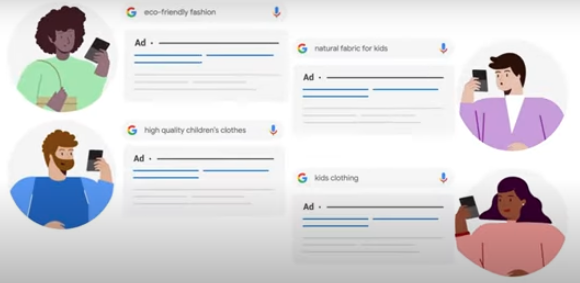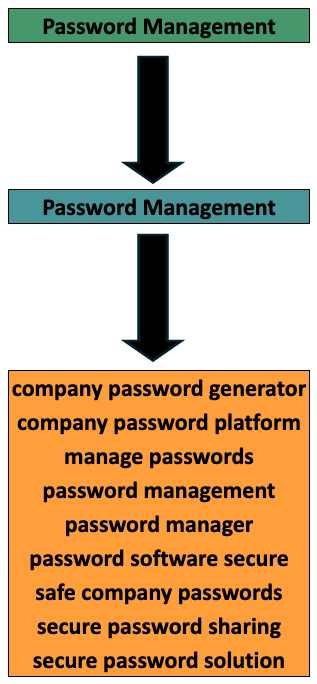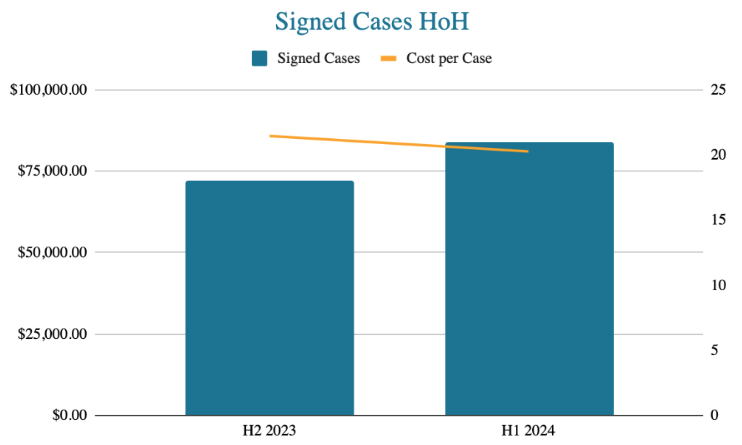
Scale Your Video Production or Sink
The B2B landscape is relentless, and mediocre video production won’t cut it. Learn why scaling high-quality video production is essential to drive ROI, stand out, and stay competitive in today’s paid media game.
Advertisers have been using Google Ads since 2000. Until the late 2010s, granular account structures often garnered the best performance. Relevance was the name of the game. Campaigns and ad groups were finely segmented by theme. In turn, the keywords in each ad group included all and close variations of the theme with keyword-dense ad copy. Here is how a “Password Management” campaign structure may look. The campaign consists of three ad groups, each with its keywords.

The structure outlined establishes a strong foundation for successful campaigns. The themes are visible, and the keywords are all relevant to their respective ad groups. Ad copy can be tailored precisely to the targeted keywords, and the landing pages are highly relevant to the themes.
In the past ten years, there has been a shift from using granular structures to using broader campaigns with fewer ad groups and more keywords. And in 2024, being too granular actually harms account performance. Campaigns and ad groups won’t see many impressions when they are too finely segmented. You may have the most compelling ad, but if users don’t see it, then it’s meaningless. Fewer impressions equate to less of a chance for revenue. We often find sales volume increases by more than 50% when campaigns are condensed while efficiency improves.
Moving to a consolidated structure does not eliminate relevance. You can still deliver customized messaging that addresses your audience’s pain points. The broader structure enables more effective optimization while allowing users to find what they want. Let’s discuss the importance of consolidation and how to continue delivering the right message to your audience.
The shift to broader campaign setups began in 2013 with the introduction of Enhanced Campaigns. The most consequential change was the addition of bid modifiers.
Advertisers could now set bid adjustments for three areas:
For instance, if an advertiser wished to increase their bid by 50% in California, a $10 bid in this state would be adjusted to $15. If mobile traffic was deemed less relevant, advertisers could apply a -20% bid modifier for this device. In this case, a $10 bid would be reduced to $8 on mobile.
Smart bidding has been around since 2013, but it wasn’t as effective as today. Bid modifiers were among the first features to adjust bids based on specific factors like device or location. With bid modifiers, breaking campaigns out by device or location wasn’t as necessary. For example, advertisers created separate campaigns for desktop and mobile with unique bids and device-specific language. Bid modifiers simplified this process, while ad customizers allowed different messaging for different devices within the same ad.
Enhanced Campaigns led to fewer and more streamlined campaigns, but smart bidding also became more powerful throughout the 2010s. Smart bidding adjusts bids dynamically based on user behavior, bidding higher for users who are more likely to convert and less for those not likely to convert. Smart bidding uses various user signals, many of which cannot be controlled with manual bidding.
These signals include:
The preferred method had always been manual bidding because of the control it allowed. However, manual bidding did not consider the additional signals that smart bidding offered, leaving advertisers without crucial information.
In 2018, a new ad type called responsive search ads (RSAs) was introduced. This ad type is directly connected to machine learning. Instead of creating ads that display precisely as written, RSAs enable advertisers to write up to 15 headlines and four description lines. Google then determines the combinations to display, aiming to feature combinations that yield better results based on user behavior.

RSAs were one of the first times advertisers let Google control which variations show. While advertisers can pin headlines and descriptions to ensure specific messages always appear, it is not recommended as it can hinder machine learning. RSAs became the default text ad format in 2022.
The consistent theme across all of these changes is that Google’s machine-learning algorithms now control levers that were previously managed by advertisers, which is not necessarily a bad thing. With the vast amount of data available to Google, it should be capable of collaborating with advertisers to achieve strong results.
Advertisers must input the correct variables, including:
Please keep in mind the following information: Machine learning is most effective when there is a large amount of data available. However, this can be challenging when dealing with highly segmented campaigns and ad groups, as they may not generate enough data for accurate analysis. For instance, Google suggests that each RSA should receive at least 1,000 impressions before evaluating its performance. In the given example, there are three ad groups, each containing an ad with 15 headlines and four description lines, resulting in a total of 45 headlines and 12 description lines for the campaigns. It is unlikely that all of these assets will receive the recommended 1,000 impressions. The solution to this issue is to consolidate the campaigns.
The first step when considering consolidation is the goal of each theme. Putting aside structure, how should each theme be deemed successful? Sometimes, it’s as simple as saying that the non-brand opps CPA needs to be under $700 or that the return needs to be 3:1. Other times, each category needs to hit a specific CPA or ROAS to be profitable. It’s essential to determine your goals for many reasons, but regarding Google Ads, these goals dictate your bidding strategies.
Conversion-based bidding strategies are most effective when there have been at least 15 conversions in the past 30 days. Some individual campaigns may not reach this threshold. If combining campaigns is not an option to gather more data, portfolio bid strategies should be set up for campaigns with the same goal. A single bid strategy can be assigned to multiple campaigns and utilize all the data. For instance, if three campaigns each have only eight conversions over the last 30 days, a portfolio bid strategy assigned to these three campaigns would use 24 conversions. Even if individual campaigns reach the threshold, it’s worth considering creating portfolio bid strategies that share the same goal. A recent Optmyzr study stated that advertisers with 50+ conversions over the 30-day period see better performance.
Now that we have considered goals by theme and bid strategies, we can review the account structure. Relevance from the query to the matched keyword to the ad seen and the landing page is still paramount, but we don’t have to be as granular. Using the password management example, we already know that having three ad groups will make getting 1,000 impressions for each asset unattainable. A more effective structure would be to combine the three ad groups into a single “password management” ad group.

With the new structure, all data funnels into one ad group. The main concern is that having many different keywords in one ad group might make the ad copy and landing pages less relevant to all the keywords. For example, users searching for “secure password sharing” might see a general ad about the company’s password management solution that leads to a page highlighting the product. The first step to address this concern is to use keyword-level URLs. This means using a more specific landing page if the keyword “secure password sharing” requires it. Even though the ad still leads to the general page, the keyword-level URL will take precedence over the ad level.
The second step is to write copy that speaks to the theme. With so many keywords in each ad group and many ad copy combinations, ensuring that the targeted keyword(s) appear in the ad can be challenging. Make sure that you are using the head term in several assets.
For example:
If users search for “company password generator,” they may see the “Manage Team Passwords” headline. A keyword-specific final URL should be used if a landing page is more relevant to the keyword than the ad. Otherwise, users will be directed to the general page. Advertisers can also utilize dynamic keyword insertion (DKI) to align more closely with the query.
There are times when it’s not possible to take a broader approach. For instance, detailed breakdowns may be necessary if campaigns need to be segmented by location or if specific themes are set by the budget. These situations will arise. That being said, consider what your account needs. Our recommendation is to take a broader approach because we’ve seen this strategy deliver the best performance. If your localization needs are the same, can you target an entire region instead of individual countries? Can multiple themes use the same budget and bid strategy?
It’s also worth noting that consolidation shouldn’t be conducted all at once. Too many changes lead to system volatility. Combining campaigns means introducing keywords into existing campaigns, writing new ad copy, and relearning bid strategies. There’s no set cadence for combining campaigns. For larger accounts, it may take up to three months, and for smaller campaigns, weeks to months.
Closed Loop clients have seen strong results when consolidating campaigns.
That said, consolidations need to be done in conjunction with the following:
For a health and wellness client, after creating a down-funnel custom goal and associating it with our campaigns, we implemented a tROAS bid strategy for our consolidated campaigns. The results were overwhelmingly positive:
In our work with a telecom provider, we combined over 100 non-brand campaigns into 40 stronger campaigns within three months. As a result, non-brand revenue increased by 110% yearly, and ROAS improved by 131%. Additionally, our spending decreased by $1.4 million. We also reduced the number of portfolio-level bid strategies, as many campaigns had similar objectives. Fewer strategies meant that each used a greater volume of data. The increased data flow improved our bid strategies and helped us generate more revenue.
With another client in the legal industry, consolidating campaigns led to a 17% increase in signed cases, half over half. In addition to consolidation, we began optimizing for signed cases instead of contact us submissions. These steps resulted in more signed cases in a highly competitive industry.

The common theme with both clients is that efficiency improved, and the conversion and revenue volume increased. While campaign consolidation may seem counterintuitive based on Google Ads’ history, it is necessary today. The system works best when it has more data to work with. Consolidation achieves this goal, whether that means more data per campaign, per bid strategy, or overall conversion volume.

The B2B landscape is relentless, and mediocre video production won’t cut it. Learn why scaling high-quality video production is essential to drive ROI, stand out, and stay competitive in today’s paid media game.

Misaligned metrics and fragmented strategies aren’t just inconvenient—they’re costing your marketing team revenue and results. Explore the root causes of data chaos and learn how to align your metrics for paid media success.

AI tools promise automation and efficiency, but without human expertise in creative, strategy, and oversight, they amplify inefficiencies. Learn how to balance AI’s strengths with human intervention to drive results.